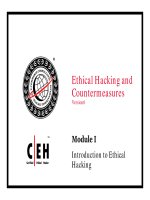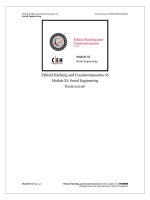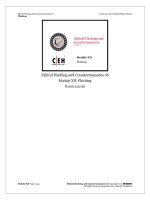Ethical Hacking and Countermeasures v6 module 17 web application vulnerabilities
Bạn đang xem bản rút gọn của tài liệu. Xem và tải ngay bản đầy đủ của tài liệu tại đây (3.73 MB, 99 trang )
Ethical Hacking and
Counterm easures
Version 6
Module XVII
Web Application
Vulnerabilities
Scenario
Kimberly,
Kimberly a web application developer works for a bank
bank,
XBank4u. Recently XBank4u introduced a new service called
“Mortgage Application Service”. Kimberly was assigned the task
of creating the application which supported the new service.
She finds ShrinkWarp, an ASP based application on the Internet.
The application suited perfectly for her development. She
negotiates the price with the vendor and purchases the software
for the firm.
She was successful in implementing the project in time. XBank4u
was ready to serve its customers online for the new service using
the application that Kimberly had designed.
A week later XBank4u website was defaced!
Was Kimberly’s decision to purchase the application justified?
Is it safe to trust a thi d pa ty application?
s
t ust third party
EC-Council
Copyright © by EC-Council
All Rights Reserved. Reproduction is Strictly Prohibited
News
Source: />
EC-Council
Copyright © by EC-Council
All Rights Reserved. Reproduction is Strictly Prohibited
Module Objective
This module will familiarize you with :
•
•
•
•
•
•
EC-Council
Web Application Setup
Objectives of Web Application Hacking
Anatomy of an Attack
Web Application Threats
Countermeasures
Web Application Hacking Tools
Copyright © by EC-Council
All Rights Reserved. Reproduction is Strictly Prohibited
Module Flow
Web Application Setup
Web Application Hacking
Web Application Threats
EC-Council
Anatomy of an Attack
Countermeasures
Web A li i
W b Application
Hacking Tools
Copyright © by EC-Council
All Rights Reserved. Reproduction is Strictly Prohibited
Web Application Setup
A client/server software application that interacts
pp
with users or other systems using HTTP
Modern applications are written in Java (or
similar languages) and run on distributed
application servers, connecting to multiple data
sources through complex business logic tiers
EC-Council
Copyright © by EC-Council
All Rights Reserved. Reproduction is Strictly Prohibited
Web Application Setup (cont’d)
EC-Council
Copyright © by EC-Council
All Rights Reserved. Reproduction is Strictly Prohibited
Web Application Hacking
Exploitative behaviors
E l i i b h i
• Defacing websites
• Stealing credit card
information
• Exploiting server-side
scripting
• Exploiting buffer overflows
• Domain Name Server (DNS)
attacks
• Employing malicious code
• Denial of Service
• Destruction of Data
EC-Council
Copyright © by EC-Council
All Rights Reserved. Reproduction is Strictly Prohibited
Anatomy of an Attack
SCANNING
INFORMATION GATHERING
TESTING
PLANNING THE ATTACK
LAUNCHING THE ATTACK
EC-Council
Copyright © by EC-Council
All Rights Reserved. Reproduction is Strictly Prohibited
Web Application Threats
Cross-site
Cross site scripting
Log tampering
SQL injection
Error message interception attack
Command injection
j
Obfuscation application
pp
Cookie/session poisoning
Platform exploits
Parameter/form tampering
DMZ protocol attacks
Buffer overflow
Security management exploits
Directory traversal/forceful browsing
Web services attacks
Cryptographic interception
Zero day attack
Cookie snooping
Network access attacks
Authentication hijacking
TCP fragmentation
EC-Council
Copyright © by EC-Council
All Rights Reserved. Reproduction is Strictly Prohibited
Cross-Site Scripting/XSS Flaws
Cross-site scripting occurs when an attacker uses a web application to send malicious
code; generally JavaScript
Stored attacks are those where the injected code is permanently stored on the target
servers in a database
Reflected attacks are those where the injected code takes another route to the victim,
such as in an email message
Disclosure of the user’s session cookie allows an attacker to hijack the user’s session and
take over the account
In
I cross-site scripting, end user fil are di l d T j h
it
i ti
d
files
disclosed, Trojan horse programs are i t ll d
installed,
the user to some other page is redirected, and presentation of the content is modified
Web servers, application servers, and web application environments are susceptible to
, pp
,
pp
p
cross-site scripting
EC-Council
Copyright © by EC-Council
All Rights Reserved. Reproduction is Strictly Prohibited
An Example of XSS
A hacker realizes that the XSECURITY website suffers from a cross-site scripting bug
The hacker sends you an e-mail that claims you have just won a vacation getaway and all you have to do is
"click here" to claim your prize
The URL for the hypertext link is www.xsecurity.com/default.asp?name=<script>evilScript()</script>
When you click this link, the website tries to be friendly by greeting you, but instead displays, “Welcome
Back !”
What happened to your name? By clicking the link in the e-mail, you have told the XSECURITY website
that your name is <script>evilScript()</script>
The web server generated HTML with this “name” embedded and sends it to your browser
Your browser correctly interprets this as script and runs the script
If this script instructs the browser to send a cookie containing your stock portfolio to the hacker's
computer, it quickly complies
After all, the instruction came from the XSECURITY website, which owns that cookie
EC-Council
Copyright © by EC-Council
All Rights Reserved. Reproduction is Strictly Prohibited
An Example of XSS (cont’d)
EC-Council
Copyright © by EC-Council
All Rights Reserved. Reproduction is Strictly Prohibited
Countermeasures
Validate all headers, cookies, query strings, form fields, and
hidden fields (i.e., all parameters) against a rigorous
specification
Adopt t i
Ad t a stringent security policy
t
it
li
Filtering script output can also defeat XSS vulnerabilities by
preventing them from being transmitted to users
EC-Council
Copyright © by EC-Council
All Rights Reserved. Reproduction is Strictly Prohibited
SQL Injection
SQL Injection uses SQL to directly manipulate database s data
database’s
An tt k
A attacker can use a vulnerable web application t b
l
bl
b
li ti to bypass normal security measures and
l
it
d
obtain direct access to the valuable data
SQL Injection attacks can often be executed from the address bar, from within application
fields, and through queries and searches
Countermeasure
• Check the user’s input provided to database queries
• V lid
Validate and sanitize every user variable passed to
d
ii
i bl
d
the database
EC-Council
Copyright © by EC-Council
All Rights Reserved. Reproduction is Strictly Prohibited
Command Injection Flaws
Command injection flaws relay the malicious code through a
web application to another system
Attacks include calls to the operating system via system calls,
the use of external programs via shell commands, as well as
commands
calls to the backend databases via SQL (i.e., SQL injection)
Scripts written in Perl, python, and other languages can be
injected into the poorly designed web applications
EC-Council
Copyright © by EC-Council
All Rights Reserved. Reproduction is Strictly Prohibited
Countermeasures
Use language-specific libraries that avoid problems due to shell commands
Validate the data provided to prevent any malicious content
Structure requests so that all supplied parameters are treated as data, rather
than potentially executable content
J2EE environments allow the use of the Java sandbox, which can prevent the
execution of system commands
EC-Council
Copyright © by EC-Council
All Rights Reserved. Reproduction is Strictly Prohibited
Cookie/Session Poisoning
Cookies are used to maintain session state in the otherwise
stateless HTTP protocol
Poisoning allows an attacker to inject the malicious
y
p
content, modify the user's on-line experience, and obtain
the unauthorized information
A proxy can be used for rewriting th session d t
b
df
iti the
i data,
displaying the cookie data, and/or specifying a new user ID
or other session identifiers in the cookie
EC-Council
Copyright © by EC-Council
All Rights Reserved. Reproduction is Strictly Prohibited
Countermeasures
Do not store plain text or weakly encrypted password in a
cookie
Implement cookie’s timeout
Cookie’s authentication credentials should be associated with
an IP address
Make logout functions available
EC-Council
Copyright © by EC-Council
All Rights Reserved. Reproduction is Strictly Prohibited
Parameter/Form Tampering
Parameter/Form tampering takes advantage of the h dd
k
d
f h hidden
fields that work as the only security measure in some
applications
Modifying this hidden field value will cause the web application
to change according to the new data incorporated
It can cause theft of services, escalation of access, and session
hijacking
Countermeasure: Field validity checking
EC-Council
Copyright © by EC-Council
All Rights Reserved. Reproduction is Strictly Prohibited
Hidden Field at
EC-Council
Copyright © by EC-Council
All Rights Reserved. Reproduction is Strictly Prohibited
Buffer Overflow
Buffer overflow is the corrupt execution
stack of a web application
Buffer overflow flaws in custom web
applications are l
li ti
less lik l t b d t t d
likely to be detected
Almost all known web servers, application
servers, and web application
environments are susceptible to attack
(but not Java and J2EE environments
except f overflows i the JVM itself)
for
fl
in h
i lf)
EC-Council
Copyright © by EC-Council
All Rights Reserved. Reproduction is Strictly Prohibited
Countermeasures
Validate input length in forms
Check bounds and maintain extra care when using loops to
copy data
StackGuard and StackShield for Linux are tools to defend
programs and systems against stack-smashing
EC-Council
Copyright © by EC-Council
All Rights Reserved. Reproduction is Strictly Prohibited
Directory Traversal/Forceful
Browsing
Directory traversal/forceful browsing attack occurs
when the attacker is able to browse directories and files
outside the normal application access
Itexposes the directory st uctu e o t e app cat o , a d
te poses t e d ecto y structure of the application, and
often the underlying web server and operating system
An attacker can enumerate contents, access secure or
restricted pages, and gain confidential information,
locate source code, and so on
EC-Council
Copyright © by EC-Council
All Rights Reserved. Reproduction is Strictly Prohibited
Countermeasures
Define access rights to the protected areas of the website
Apply checks/hot fixes that prevent the exploitation of the
vulnerability such as Unicode to affect directory traversal
Web servers should be updated with security patches in a
timely manner
EC-Council
Copyright © by EC-Council
All Rights Reserved. Reproduction is Strictly Prohibited









